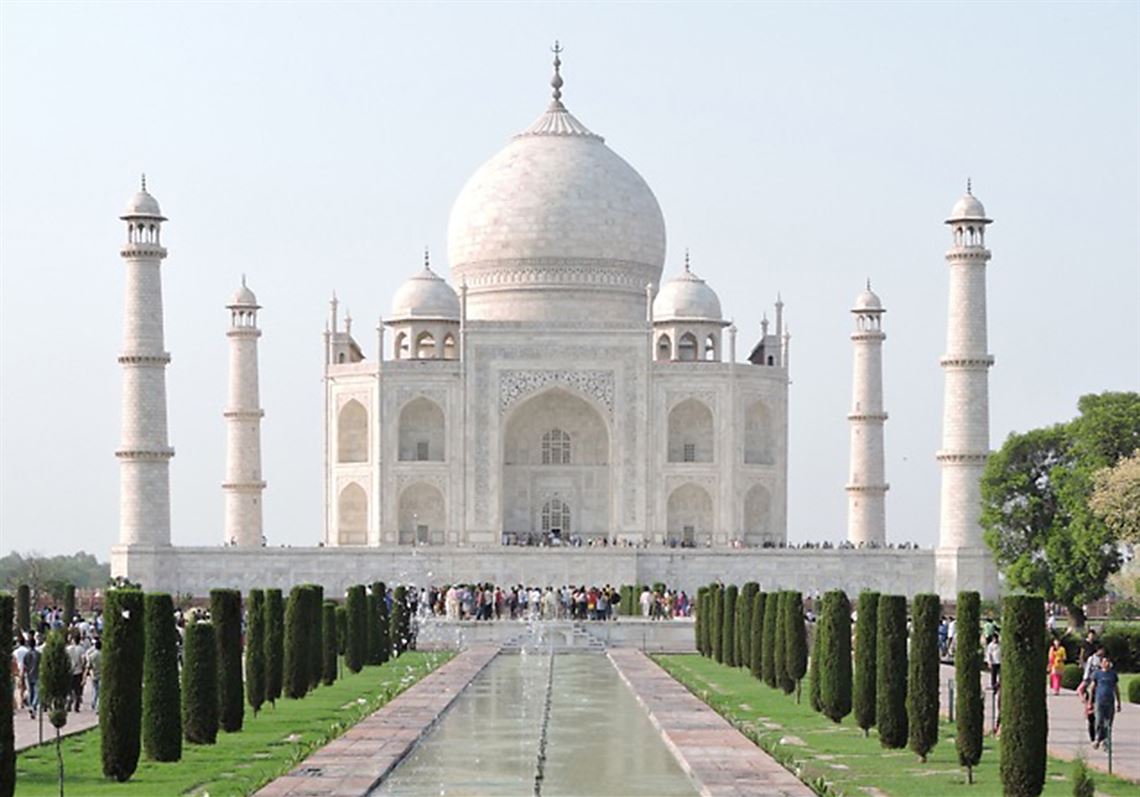Taj Mahal
India’s Taj Mahal is not only one of the country’s major landmarks, but also a monument to human civilisation.
The monumental and majestic structure is imagined by many, but the story behind this architectural complex is even more moving. The Taj Mahal is often listed as one of the new wonders of the world or even as the eighth wonder of the world. The great poet Rabindranath Tagore called the Taj Mahal “A tear on the cheek of eternity” or, in translation, “A tear on the cheek of immortality”.
Description
The Taj Mahal is one of the most remarkable buildings not only of its time but of all time, as it is an impressive combination of Arabic, Persian and Indian styles. This architectural complex with a huge mausoleum was built by the ruler of Agra, Shah Jahan, for his wife Mumtaz Mahal. The white marble of which the walls of the Taj Mahal are made has a “magical” property: it is white in daylight, pink at dawn and silver on moonlit nights.
Construction of the shrine
The construction of the Taj Mahal began in 1632 and took twenty-one years (while the tomb was completed ten years earlier). To build this unique complex, more than 20,000 workers from all over India, as well as architects, artists and sculptors from nearby countries, were involved.
An area of 1.2 hectares was excavated near the city (Agra) and the soil was changed to make it softer. The level of the area to be built for the mosque was raised 50 metres above the coastline. The workers dug pits and filled them with natural earth stones, creating a foundation that would also act as a kind of anti-seismic cushion and prevent the complex from collapsing.
An interesting fact: instead of bamboo scaffolding, the architects decided to use brick scaffolding: it was easier to work with the heavy marble. The stone scaffolding looked so imposing that the architects feared it would take several years to dismantle it. Jahan found a way out by announcing that any citizen of Agra could collect the required number of bricks, and the scaffolding was dismantled in a few days.
To carry the building materials to the mosque, the Hindus constructed a slightly inclined earthen platform on which oxen dragged the load in specially designed carts. These were transported to the city from all over India (and beyond). The most important building material, white marble, was brought to the city from Makrana and Rajasthan, 300 km from Agra.
The marble blocks were raised to the required height with the help of special devices. The water required for the construction work was first drawn from the river and then poured into the reservoir, from where it was lifted into a special tank and sent through pipes to the construction site.
View from inside
The interior of the Taj Mahal (Agra City) is no less remarkable than the exterior. The entrance to the mausoleum is adorned by an elegantly colonnaded gallery. The hall inside the mausoleum is an octagon that can be accessed from either side of the mausoleum (now it can only be accessed from the park side). Inside the room, behind a marble partition, are two white marble sarcophagi, which are actually false tombs, as the tombs themselves are located under the floor.
The lid of the sarcophagus of the ruler’s wife has inscriptions praising her. The only asymmetrical element in the entire complex is the sarcophagus of Jahan, which was placed there after his death: the ruler’s tomb is slightly larger than that of his wife. The walls inside the building are 25 metres high and the ceiling, decorated in the sun, is made like an interior dome.
The entire interior space of the hall is divided by eight arches on which quotations from the Qur’an can be read. The four central arches form balconies with windows through which light enters the hall (apart from these windows, sunlight enters the hall through special holes in the ceiling). It is possible to climb to the first floor of the mausoleum by one of the two side staircases. The walls inside the mausoleum are decorated with mosaics of semi-precious stones forming various symbols, plants, flowers and letters.
Where it is located
The Taj Mahal is located on the banks of the Yamuna River in Uttar Pradesh, near the city of Agra. A site seven kilometres from the city was chosen for its construction. On the opposite bank of the Taj Mahal, it was hoped to build another mausoleum where Shah Jahan himself would have been buried, but the project was eventually abandoned.
You may also like:
